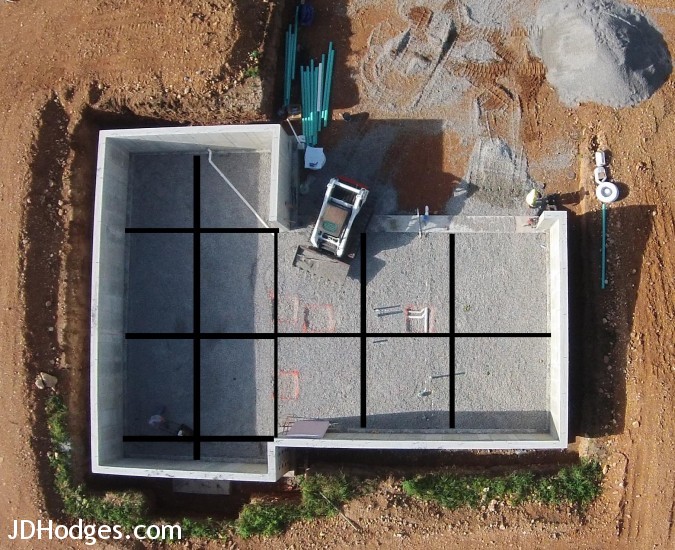We are building a house and I have been learning a bit more about concrete lately. You may know the old saying ‘there is only one sure thing with concrete, it WILL crack’. 😉 Of course the trick is getting it to crack where you want to 🙂
‘Control joints’ are cuts made in the concrete so that hopefully when the slab cracks it will follow the pre-made cut. This is the control joint layout that I came up with:

Black lines indicate control joints
The idea is to control cracking at the inside corners as well as near the thickened slab portions of the basement.
Please disregard the fisheye distortion in the photo as the foundation is actually square 🙂
Also, here are some articles that I found interesting:
Control joints

Contraction/Control Joints in Concrete Flatworkhttp://www.cement.org/for-concrete-books-learning/concrete-technology/concrete-construction/contraction-control-joints-in-concrete-flatworkContraction/control joints are placed in concrete slabs to control random cracking. A fresh concrete mixture is a fluid, plastic mass that can be molded into virtually any shape, but as the material…
Additives

Chemical Admixtureshttp://www.cement.org/cement-concrete-basics/concrete-materials/chemical-admixturesRetarding admixtures, which slow the setting rate of concrete, are used to counteract the accelerating effect of hot weather on concrete setting. High temperatures often cause an increased rate of…
“Superplasticizers, also known as plasticizers or high-range water reducers (HRWR), reduce water content by 12 to 30 percent and can be added to concrete with a low-to-normal slump and water-cement ratio to make high-slump flowing concrete. Flowing concrete is a highly fluid but workable concrete that can be placed with little or no vibration or compaction. The effect of superplasticizers lasts only 30 to 60 minutes, depending on the brand and dosage rate, and is followed by a rapid loss in workability. As a result of the slump loss, superplasticizers are usually added to concrete at the jobsite.”
Source: http://www.cement.org/cement-concrete-basics/concrete-materials/chemical-admixtures

Concrete Additiveshttp://www.freemanrock.com/concrete-additivesConcrete Sealer Seal Pro MS300 is a clear deep penetrating, non-yellowing solvent base sealer designed for concrete substrates. It protects and preserves as a surface hardener, dust proofing agent…
Radiant Heating Tubing (PEX etc.) and Control Joints
Control joints after pouring concrete over the PEX tubeshttp://www.greenbuildingtalk.com/Forums/tabid/53/aff/12/aft/82435/afv/topic/Default.aspxWhat is a good and secure method to have control joints made in concrete that was poured over PEX tubes for radiant floor heating? How can…

Contraction Joints for Radiant-Heated Floors | ForConstructionPros.comhttp://www.forconstructionpros.com/article/10116876/contraction-joints-for-radiant-heated-floorsInstalling saw-cut contraction joints in radiant-heated floors is similar to standard slab-on-ground floors except placing and maintaining reinforcement and tubing locations are critical. Otherwise,…
[end]






